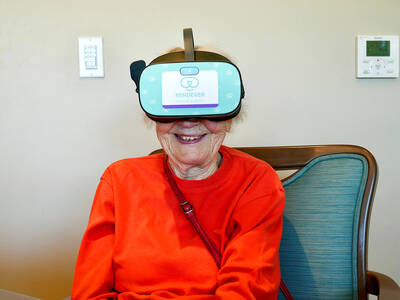The celebration of Durga Puja in the New Taipei City Library in Sijhih District (汐止) early this month shows once again the deepening cultural and educational ties between Taiwan and India.
Illustrating the deepening ties, Sujeet Kumar, an Indian member of parliament and Taiwan enthusiast, also attended the festival, which had extra significance due to it being recognized for its cultural value by the UN.
UNESCO this year inscribed Durga Puja on its Representative List of Intangible Cultural Heritage of Humanity and lauded the festival “as the best instance of public performance of religion and art... During the event, the divides of class, religion and ethnicity collapse as crowds of spectators walk around to admire the installations.”

Photo courtesy of Nandana Biswass
Durga is an important Hindu goddess and is worshiped as the symbol of the triumph of good over evil. The goddess, riding a tiger or lion, is associated with the protection of her children and fights demons and destructive forces.
The resolve and infinite energy of Durga is a persona that some in the Indian community feel President Tsai Ing-wen (蔡英文) embodies, as she remains calm in the face of the saber-rattling behemoth across the Taiwan Strait.
Although the festival is celebrated every year in October, primarily by the Bengali community, of late it has acquired a pan-India character and as such it is now celebrated in Indian communities across the globe.
The 10-day festival begins with Mahalaya, when the chanting of hymns consecrated to Durga permeates the ambiance in crescendo with the beating of the drums and the blowing of conks.
Due to Taiwan’s religious diversity and tolerance, the Indian community, estimated to be over 5,000, has started celebrating festivals like Durga Puja and Dewali (the festival of light) with gusto, receiving the wholehearted support and cooperation of locals and civic authorities in terms of finding proper venues.
It augurs well that, although India and Taiwan may not share formal diplomatic relations, the extent to which the two have moved closer culturally and educationally in recent years could not have been imagined decades earlier.
The relationship between civil society and coverage in the media both in India and Taiwan also raised awareness among the people and empathy for each other has grown phenomenally.
Rup Narayan Das is a Taiwan Fellow at National Chung-Hsing University and author of the book ‘Hong Kong Conundrum: Pangs of Transition.’

The Directorate-General of Budget, Accounting and Statistics (DGBAS) told legislators last week that because the Chinese Nationalist Party (KMT) and Taiwan People’s Party (TPP) are continuing to block next year’s budget from passing, the nation could lose 1.5 percent of its GDP growth next year. According to the DGBAS report, officials presented to the legislature, the 2026 budget proposal includes NT$299.2 billion in funding for new projects and funding increases for various government functions. This funding only becomes available when the legislature approves it. The DGBAS estimates that every NT$10 billion in government money not spent shaves 0.05 percent off

Dec. 29 to Jan. 4 Like the Taoist Baode Temple (保德宮) featured in last week’s column, there’s little at first glance to suggest that Taipei’s Independence Presbyterian Church in Xinbeitou (自立長老會新北投教會) has Indigenous roots. One hint is a small sign on the facade reading “Ketagalan Presbyterian Mission Association” — Ketagalan being an collective term for the Pingpu (plains Indigenous) groups who once inhabited much of northern Taiwan. Inside, a display on the back wall introduces the congregation’s founder Pan Shui-tu (潘水土), a member of the Pingpu settlement of Kipatauw, and provides information about the Ketagalan and their early involvement with Christianity. Most

The People’s Republic of China (PRC) was out in force in the Taiwan Strait this week, threatening Taiwan with live-fire exercises, aircraft incursions and tedious claims to ownership. The reaction to the PRC’s blockade and decapitation strike exercises offer numerous lessons, if only we are willing to be taught. Reading the commentary on PRC behavior is like reading Bible interpretation across a range of Christian denominations: the text is recast to mean what the interpreter wants it to mean. Many PRC believers contended that the drills, obviously scheduled in advance, were aimed at the recent arms offer to Taiwan by the

Like many retirement communities, The Terraces serves as a tranquil refuge for a nucleus of older people who no longer can travel to faraway places or engage in bold adventures. But they can still be thrust back to their days of wanderlust and thrill-seeking whenever caretakers at the community in Los Gatos, California, schedule a date for residents — many of whom are in their 80s and 90s — to take turns donning virtual reality headsets. Within a matter of minutes, the headsets can transport them to Europe, immerse them in the ocean depths or send them soaring on breathtaking hang-gliding expeditions